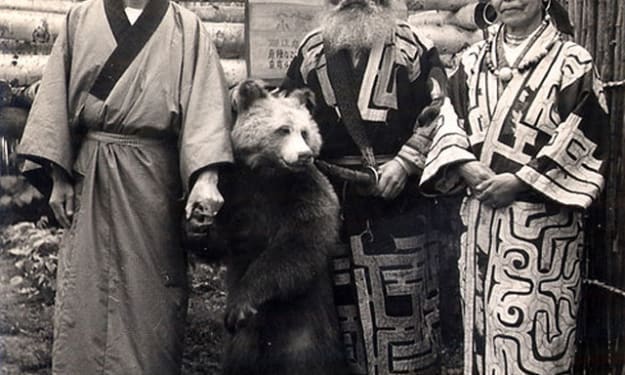The Two-Spirits of Montana
A History of the Boté from the Pre-Columbian Era, Through the Conquest of Montana, to Today's LGBT Advocacy

In Montana’s pre-Columbian history, there was a tradition of young boys and girls realizing that they were two-spirit and entering a new style of life which they felt better represented them. The two-spirit are a third gender with a variety of names, two-spirit being a modern pan-Indian term to replace the problematic previous anthropological term berdache, which derives from the Arabic word for eunuch slaves, which obviously carries an offensive connotation to the two-spirit. Two-spirit individuals would be born one gender, and once they realized their true nature, they would take up some or all of the responsibilities of the opposite gender. This meant that two-spirit would inhabit interesting and often important roles within their tribe. Unfortunately, as Western powers encroached on Native lands, they were disgusted by the two-spirit and repressed them, arresting them with little cause, writing poorly of them—often lying—and teaching the children of Native tribes that two-spirit were immoral. This repression caused a decline in two-spirit numbers, and many tribes lost their two-spirit community entirely. However, in the modern era there has been a resurgence of two-spirit individuals who are attempting to do activism in order to gain (or regain) acceptance, both in Native and non-Native communities.
Two-spirit individuals held respected positions within their tribes, and for a variety of reasons. Two-spirit who were born male, like the boté of the Crow Nation, were a great boon economically to their tribes. While women made crafts just as the boté did, the women would eventually have to raise children, taking time away from what they would have spent making these crafts. Meanwhile the boté would have more time to perfect their craft, becoming highly skilled laborers for the tribe. They could do most anything the women could, but they had more free time to do it. They would even help to raise children sometimes, serving as a support network for overworked mothers and orphaned children. They also had a significant role to play in the Crow religion. They were often necessary for ceremonies and were a conduit to the spiritual world for the rest of the tribe. For example, in the Sun Dance ceremony, there was a special lodge built around a tall central pole which needed to be secured by such “threshold figures” as the boté. One good example of the boté and the versatile role they played in the tribe is that of Woman Jim, or Finds Them and Kills Them as he was also known. Despite being two-spirit, Finds Them and Kills Them earned a reputation during the war between the Crook and Crow and the Cheyenne and Sioux for his fighting, at one point even rescuing a warrior named Bull Snake from the Lakota with the help of only one other person, The Other Magpie, a female. While The Other Magpie was looked down on for her role in the rescue because of her eschewing of gender roles, Finds Them and Kills Them was not, showing that the place of the two-spirit in Crow culture was a lot more fluid than simply being a man who did a woman’s job.
In other tribes, there were those who were born female and were two-spirit. While this is not a very common occurrence among the Plains Indians who inhabited Montana, there were some notable examples. Sticking with the Crow for a bit, there is perhaps the most famous example of Woman Chief, who started life as a Gros Ventre and ended as an important Crow chief. Woman Chief was abducted as a child by the Crow and was adopted by one of their warriors. While Woman Chief continued to wear the clothes of a woman, she participated in traditionally male activities, including becoming the chief after her adopted father died, doing much good for the tribe until her death at the hand of her native tribe. There is also the story of the Kutenai woman who claimed to have been turned into a man by her white husband after she returned to the tribe, although this is not exactly the same idea and may just be a tall tale told to make the Native seem weirder to Western audiences.
Western observers of two-spirit people were often shocked by what they saw. To them this crossing of gender roles was a egregious display of immorality. The Western groups who had the most interaction with Montana Natives were the French and the Americans. The Americans in particular disliked two-spirit people, as shown in the first American ethnography of the Crow by a fur trader named Edwin Thompson Denig, who wrote that the boté “is seldom much respected by either sex,” a lie about their position in Crow society. In his examination of the Crow “Berde’ches or hermaphrodites” as he puts it, he states that, “Most civilized communities recognize but two genders, the masculine and feminine. But strange to say, these people have a neuter.” As a very dismissive account of the two-spirit, it is very typical of the kind of reception that the people of this gender would receive from Westerners through most of their history. In the 1900s, anthropologist Robert H. Lowie, who was instrumental in the development of modern anthropology and was an expert on Native Americans, described two-spirits as “pathological,” “psychiatric cases,” “abnormal,” “anomalies,” “perverts,” and “inverts.” At this same time, two-spirits like Woman Jim of the Crow were being harassed by federal agents trying to bring them in line with Western morals. For those who had been born male, these agents would strip them, cut their hair, and force them to wear men’s clothing. Only the intervention of the chief could save them from this fate, and due to Western missionary and educational influences, many chiefs would not interfere.
Today, two-spirit people are a little known or understood aspect of Native American culture who struggle to gain broader acceptance. Even organizations and groups which would normally have a great deal of sympathy towards non-binary individuals have issues of cultural appropriation regarding the two-spirit. Many LGBT communities have a hard time understanding that being two-spirit is different than being gay or trans. It has a cultural meaning, and if they take up the title they are stealing a piece of Native American culture which they were not given permission to use. Another big issue facing the two-spirit is that many Native American communities and tribes don’t accept them. The reeducation that Americans forced on Native Americans for so many years still has a lasting effect, and many Native groups believe the two-spirit, for one reason or another, should not be welcomed. These two problems remove a great deal of the community that modern two-spirits would otherwise share, being unwelcome in Native American groups and even whole tribes, but also feeling uncomfortable in LGBT groups because of the cultural insensitivity. Through hard work and struggle, many of the two-spirits have formed groups all around North America, including the Montana Two Spirit Society in Browning, founded in 1996 with nearly 100 members.
Despite being relatively unheard of in the modern day, two-spirit individuals have a long history in Native American societies. In Montana, there are a few particularly notable two-spirit people, such as Woman Jim, the Kutenai Woman, and Woman Chief. These people were craftsmen, warriors, religious leaders, and chiefs. Despite what the Americans said, they were greatly respected by their tribes and held important positions within them. These people were suppressed by the U.S. government because they didn’t conform to the strict Western morality standards of the time. Today the two-spirit gendered people of tribes throughout North America fight to gain acceptance not just within their tribes, but in the United States at large. With this struggle comes new understanding of the two-spirit and a better appreciation of Montana’s pre-Columbian queer history.
About the Creator
History Roundtable
Owner of a history degree and occasional writer of things






Comments
There are no comments for this story
Be the first to respond and start the conversation.